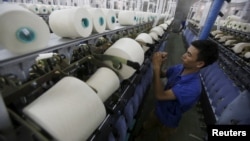For Southeast Asia, the slowdown of China’s economy may have a bigger economic impact than the British vote to leave the European Union.
China’s government reported the country’s economy expanded at 6.7 percent in the first three months of this year. That is high compared to many countries. However, it is the lowest increase of its Gross Domestic Product, or GDP, since early 2009. GDP is a measure of the monetary value of all goods and services produced in a country.
Joseph Incalcaterra is an economist with the British bank HSBC.
He has studied economic growth in Asia from 2000 to 2014. He says Chinese trade became more and more important in the area during those years. Yet, he notes that China’s slowing economy is, in his words, “weighing down exports in the rest of the region.”
Estimates place the value of Southeast Asia’s economies at $2.6 trillion dollars. However, growth has slowed in seven of the 10 members of the Association of Southeast Asian Nations (ASEAN).
Indonesia has been most affected, at least partly because it exports commodities such as raw materials to China.
However, Southeast Asia’s relatively young population and increasing wealth keep growth possible, although its exports to China are slowing.
Earlier this year, the Asian Development Bank predicted economic growth of 4.5 percent for this year and 4.8 percent for 2017 for the area.
Le Hong Hiep is with the Singapore-based research group ISEAS-Yusof Ishak Institute. He said he has not seen a lot of impact from China’s economic slowdown in Vietnam. He said last year, Vietnam’s exports to China grew by almost 15 percent. He said those exports which are mainly raw materials and agricultural products are less affected by a slowing economy.
Southeast Asian countries such as the Philippines, Myanmar, Vietnam and Laos have had changes in political leadership recently. But that has not stopped the flow of foreign investment to the area. Not only China, but India, Russia and the United States have been increasing investment in the area.
Trade between the U.S. and Vietnam increased to $45 billion in 2015. In addition to existing trade, U.S. President Barack Obama has pushed for the Trans Pacific Partnership trade agreement.
The trade deal includes 12 Pacific nations. Four of those countries, Brunei, Malaysia, Singapore and Vietnam, are in Southeast Asia. Supporters say the deal counterbalances China’s influence in the area’s economy.
Brian Eyler is deputy director of the Stimson Center’s Southeast Asia Program. He thinks U.S. investment in the area will continue to increase. He says, “We see the U.S. investing more in Southeast Asia, training more, restructuring its diplomatic architecture, to better integrate with Southeast Asia.”
Eyler said India and Russia are seeking to do the same. He noted that China’s slowdown leaves roads, ports and other public systems underused. In his words, “No one wants to see that go to waste.”
I’m Dorothy Gundy.
Shannon Van Sant reported this story for VOA News. Mario Ritter adapted it for VOA Learning English. Caty Weaver was the editor.
_____________________________________________________________
Words in This Story
impact – n. a notable result, a powerful effect
monetary – adj. of or relating to the money in a country's economy
commodity – n. something that is bought and sold
counterbalance – v. to limit or balance out, having an opposite but equal effect
architecture – n. a structure, something that is built up
integrate – v. to bring together into a whole sides or groups that were not together before









